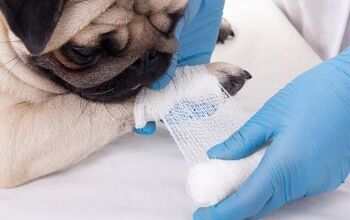4 Basic First Aid Tips For Cat Emergencies

Knowing what steps to take during an emergency involving your cat can be the difference between life and death. Basic first aid can stabilize your kitty until you can reach the vet, where he can get the prompt treatments he’ll need to make a full recovery. Consider taking a course on pet first aid, but below are a few tips to get you started.
Knowing What’s Normal for Your Cat
If you lay your kitty down on his right side, you’ll be able to feel his heartbeat at the point where his left elbow touches his chest. You can also feel the pulse by touching the inner thigh after laying your cat down on his side and gently lifting the upper hind leg away from the lower leg. Put two fingers as high up on the inside of either leg as possible, where the leg and body meet. You should feel a recess around the middle of the leg, which is where the pulse can be felt. A cat’s heart rate should be between 160 and 220 beats per minute.
Related: How To Administer Medications To Your Cat
If you have a thermometer, take your cat’s temperature, which should be between 100°F and 102.5°F. And check your pet’s breathing rate, which should be between 20 and 30 breaths per minute. Finally, lift your cat’s lower or upper lip to check the color of the mucous membranes, which should be pink. They shouldn’t be pale yellow, white, brick red, cherry red, brown, or blue, as these colors are all indicative of an emergency. If you press your finger gently on the gums, they should turn white briefly and then back to pink again after one or two seconds. If there’s a delay in this capillary refill time or if the color returns too quickly, your cat should see a vet right away.
Burns
First degree burns are superficial and characterized by red skin, tenderness, pain, swelling, and singed fur. Second degree burns go deeper and result in blisters, redness, tenderness, swelling, and loss of fur. Third degree burns involve all the layers of the skin, along with blood vessels, and cause a lot of damage. Skin that isn’t sensitive to touch, as well as loss of skin, swelling beneath the skin, black, leathery, or whitish skin, and shock are all symptoms of third degree burns.
Related: Natural Remedies for Feline Arthritis
Apply cool water to the affected areas as soon as you can. You can also place a cool compress or a moist, clean cloth or sterile nonstick pad on the burns. Never put any butter, petroleum jelly, or ointments on burns. Instead, take your cat to a vet immediately. In the case of a powdered chemical burn, brush off the powder before applying the water.
Dehydration
Dehydration can occur as a result of vomiting, diarrhea, fever, refusal to eat or drink, exposure to excessive heat, and an increase in urination. Symptoms include excessive thirst, a dry mouth with dry gums, sunken eyes, a loss in skin elasticity, and changes in urination habits. To determine if your cat is actually dehydrated or not, pull up the skin behind your cat’s neck between the shoulders gently. The skin should return back to a normal position right away, usually within two seconds. If it goes back to its original position slowly, your cat is dehydrated. If your cat is very old, very skinny, or obese, this test will be difficult to perform, so feel the gums to see if they’re sticky or dry, which is a sign of dehydration as well.
You need to take your dehydrated pet to the vet right away, especially if he’s vomiting and isn’t eating or drinking. The vet will be able to provide intravenous fluids to rehydrate your pet quickly. If you’re in doubt as to whether or not your pet is dehydrated, play it safe and bring him to the vet.
Hypothermia
Hypothermia occurs when your cat’s body temperature drops drastically. Your pet’s temperature will be below 95°F, the heart rate will be slow, the mucous membranes will be blue or pale, the pupils may be dilated, the pulse will be weak, and the body will be shivering. This is a medical emergency, and you must bring your cat to the vet right away, but you should take the following steps in the meantime.
Remove your cat from the cold environment and wrap him in a blanket. Placing warm water bottles, wrapped in towels, next to your cat will keep him warm while you get him to the vet. Once again, a course in pet first aid, which will teach you how to look for signs of shock and how to treat it, as well as how to perform CPR if needed, would come in handy in the case of a feline suffering with hypothermia.

Lisa Selvaggio is a freelance writer and editor, and our resident cats-pert, with certifications in pet nutrition and pet first aid. She enjoys producing content that helps people understand animals better so they can give their pets a safe and happy home.
More by Lisa Selvaggio























